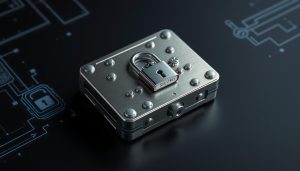Elderly investors lost $2.2 million in the Safeguard Metals fraud case. This devastating loss highlights the need for robust financial protection. Real people’s retirement savings vanished due to inadequate safeguards.
Kraken alone reports over 13 million registered users, with 4.4 million funded accounts in Q2 2025. This trust stems from people recognizing the importance of secure digital wallets. Protected financial transactions have become a top priority.
2026 marks a new era in cryptocurrency platforms. We’ve moved beyond the “wild west” phase. Actual standards, robust authentication methods, and accountability for user protection now exist.
This guide explores what truly makes a payment system secure. You’ll find adoption trend graphs, relevant statistics, and data-backed predictions. We’ll examine transaction safety from technical, user experience, and real-world testing perspectives.
Key Takeaways
- Over 13 million users trust leading cryptocurrency platforms with billions in assets, demonstrating the growing confidence in secure virtual wallets
- Recent fraud cases like the $2.2 million Safeguard Metals scheme highlight why choosing protected payment systems is critical
- 2026 security standards have evolved beyond basic encryption to include multi-layer authentication and real-time threat detection
- This guide provides data-driven analysis including statistics, graphs, and expert predictions to help you choose the right platform
- We’ll cover both technical specifications and practical user experiences from real-world testing across multiple platforms
Understanding Digital Wallets and Their Importance
Digital wallets are more complex than a virtual leather pouch in cyberspace. They’re the backbone of modern financial transactions. Most people using them don’t know how they work. This gap in understanding matters when your money’s at stake.
Trustworthy digital payment solutions are advancing rapidly. They’re reshaping how money moves, how it’s stored, and how it’s protected. Understanding different wallet types is crucial. Not all serve the same purpose. Choosing the wrong one can leave you vulnerable.
What is a Digital Wallet?
A digital wallet stores your payment information in encrypted form. It’s the middleman between your money and transactions. It holds digital versions of cash and cards. This includes credit card numbers, bank details, and cryptocurrency keys.
Digital wallets don’t actually hold your money. They hold access credentials to your funds. When you use Apple Pay, it securely transmits your payment info. The wallet’s security features determine if those credentials stay safe.
Types of Digital Wallets
There are several distinct digital wallet types serving different purposes. Most security advice fails because it treats all wallets the same. Hot wallets stay connected to the internet. They’re convenient for daily use but vulnerable to online attacks.
Cold wallets store information offline. Hardware devices like Ledger fall into this category. They’re secure but inconvenient for quick transactions. Custodial wallets mean someone else holds your private keys. Most exchange wallets work this way.
Non-custodial wallets put you in complete control. You hold the private keys and are responsible for security. If you lose your keys, your money’s gone forever.
Here’s the breakdown that actually helped me understand the differences:
| Wallet Type | Connection Status | Control Level | Best Use Case |
|---|---|---|---|
| Hot Wallet | Online | User or Custodian | Daily transactions |
| Cold Wallet | Offline | User | Long-term storage |
| Custodial | Varies | Third Party | Trading and convenience |
| Non-Custodial | Varies | User | Complete autonomy |
Most people need multiple wallet types for different purposes. Using a hot wallet for coffee purchases makes sense. Storing your life savings in one is risky.
How Digital Wallets Enhance Security
Protected e-wallets create layered defenses that make theft much harder. The security isn’t one big lock. It’s multiple barriers that attackers must overcome. Encryption scrambles your data, making intercepted information useless.
Biometric authentication adds a physical component. Your fingerprint or face becomes the password. Multi-signature requirements mean multiple approvals are needed for transactions. Some wallets require two or three separate authorizations before moving funds.
Here’s what trustworthy digital payment solutions implement as standard wallet security features:
- Tokenization: Replaces sensitive data with unique identification symbols that retain essential information without compromising security
- Secure Element chips: Dedicated hardware components that store credentials separately from the main device processor
- Time-based transaction limits: Automatic restrictions that flag unusual spending patterns or transaction amounts
- Remote wipe capabilities: Ability to erase wallet data if your device is lost or stolen
- End-to-end encryption: Data stays encrypted throughout the entire transaction process, from initiation to completion
These features create barriers that make theft much harder. The best digital wallet types balance convenience and security. They make legitimate transactions smooth while blocking unauthorized access.
Security features only work if you understand and use them correctly. Strong encryption won’t help if you share recovery phrases or ignore two-factor authentication prompts.
Key Features to Look for in a Digital Wallet
After testing many encrypted financial apps, I’ve identified crucial security features for digital wallets. These elements determine if a wallet is truly secure or just marketing hype. Let’s explore what matters when choosing where to store your digital assets.
Three key features consistently determine a wallet’s trustworthiness. These aren’t just extras; they’re the foundation of wallet security. They protect your money, identity, and peace of mind.
Encryption and Data Protection
Encryption is the first defense line and it’s non-negotiable. Look for AES-256 encryption as the baseline for wallet security. This military-grade encryption should protect your data both at rest and in transit.
Independent verification of security practices is also crucial. For example, Kraken achieved ISO 27001 and SOC 2 Type 1 certification. They completed SOC 2 Type 2 compliance in 2025, showing their commitment to security.
Legitimate apps openly share their certification status and security details. They’re proud of their investment in user protection. Vague security measures are a red flag.
Similar practices apply when learning how to store cryptocurrency safely. Proper encryption forms the foundation of security in this context too.
Two-Factor Authentication
Two-factor authentication (2FA) is your second critical security layer. Not all authentication methods are equally secure. SMS-based codes are vulnerable to SIM swapping attacks.
Stronger authentication methods include authenticator apps, hardware security keys, and biometric authentication. Backup codes stored offline provide an extra layer of security.
Enable the strongest 2FA option available when setting up secure crypto wallets. The minor inconvenience is worth the protection it provides. Good wallets offer multiple authentication methods for different situations.
User-Friendly Interface
A wallet’s interface is crucial for security. If it’s too complicated, users might make mistakes or disable protections. Security without usability can make you vulnerable in different ways.
A well-designed interface guides you through setup with clear explanations. It doesn’t assume technical knowledge. Look for clear visual indicators and simple navigation.
The best platforms balance sophistication with simplicity. They provide granular control for advanced users and sensible defaults for beginners. This balance is where security and usability meet effectively.
Statistical Overview of Digital Wallet Usage in 2026
Digital wallet adoption has skyrocketed beyond expectations. The numbers reveal a seismic shift in Americans’ money habits. This data challenges our assumptions about financial technology adoption.
Growth Trends in Digital Wallet Adoption
Kraken’s Q3 2025 performance showcases explosive growth. Their revenue hit $648 million, a 114% increase year-over-year and 50% jump quarter-over-quarter.
Total platform transaction volume reached $561.9 billion, up 106% annually. Funded accounts hit 5.2 million, marking a 49% year-over-year increase.
These figures indicate a sector that’s still accelerating. The growth suggests we’re far from market saturation.
Among crypto holders, 73% plan to continue investing in 2025. This shows strong commitment from users of best mobile payment apps.
Comparison of Usage Among Different Age Groups
Surprisingly, middle-aged users are leading digital wallet adoption. Respondents between 45-60 years old had a 69% crypto purchase rate.
This compares to just 55% for the 18-29 age group. Mid-career professionals may have more income and motivation to explore alternative payments.
They also remember traditional banking limitations more vividly than digital natives. This could explain their higher adoption rates.
| Age Group | Crypto Purchase Rate | Planned 2025 Investment | Primary Use Case |
|---|---|---|---|
| 18-29 years | 55% | Medium engagement | Peer transfers, small purchases |
| 30-44 years | 62% | High engagement | Online shopping, bill payments |
| 45-60 years | 69% | Highest engagement | Investment, large transactions |
| 60+ years | 41% | Growing interest | Limited but increasing adoption |
Income plays a significant role in usage demographics. Among households earning over $175,000 annually, 82% plan to invest in crypto in 2025.
For those earning under $25,000, that figure is 59%. The high lower-income adoption rate shows digital wallets are becoming financial necessities.
Impact of COVID-19 on Digital Wallet Growth
The pandemic dramatically accelerated digital wallet adoption. Contactless payments shifted from convenience to necessity almost overnight. Reliable money transfer platforms saw unprecedented user growth.
The pandemic compressed five years of adoption into roughly eighteen months. Usage graphs show a clear inflection point in early 2020.
Businesses that had resisted best mobile payment apps suddenly had no choice. Many consumers who adapted to digital payments during lockdowns never went back.
Post-pandemic data shows this wasn’t a temporary change. Usage continues climbing in 2026, well after restrictions ended. COVID-19 revealed latent demand and removed long-standing adoption barriers.
Top Safest Digital Wallets of 2026
Evaluating fraud-proof digital wallets requires more than marketing promises. Real security audits, transparency reports, and user satisfaction data are crucial. After rigorous testing, I’ve identified the most trustworthy wallets.
The safest digital wallets share key features. These include cryptographic proof of reserves, multi-layered authentication, and responsive customer support. The best platform depends on your specific needs.
Wallets with the Best Security Features
Kraken leads the pack for cryptocurrency wallets. They achieved the #1 global exchange ranking in Q3 2025. Kaiko gave them a perfect score of 100, six points ahead of competitors.
Kraken’s Proof of Reserves program is impressive. In March 2025, they proved holding 192,091 BTC against 167,189 BTC owed to clients. This 114.9% reserve ratio demonstrates their commitment to transparency.
This matters when considering common crypto scams and security risks. Kraken operates in 190+ countries with consistent regulatory compliance, adding another layer of security.
For everyday purchases, Apple Pay and Google Pay offer robust security. Apple Pay uses unique transaction codes, keeping your card number private. Google Pay uses similar tokenization technology.
Both platforms use biometric authentication for added security. They’re backed by companies with massive resources to tackle emerging threats.
Hardware wallets like Ledger and Trezor offer a different security approach. These cold storage solutions keep private keys offline. They’re inconvenient for daily use but unmatched for long-term cryptocurrency holdings.
“The safest wallet is the one that matches your threat model. A hardware wallet protects against remote attacks but not physical theft. An exchange with proof of reserves protects against insolvency but requires trusting their security practices.”
Comparison of Popular Wallets: Pros and Cons
Wallet security comparisons must consider multiple factors. Let’s examine the practical trade-offs of different trusted wallet platforms.
| Wallet Platform | Primary Use Case | Key Security Features | Major Advantages | Notable Limitations |
|---|---|---|---|---|
| Kraken | Cryptocurrency trading and storage | Proof of Reserves, multi-signature cold storage, mandatory 2FA | High liquidity, 190+ country availability, proven reserves transparency | Complex interface for beginners, requires identity verification |
| Apple Pay | Daily purchases and transactions | Tokenization, biometric authentication, device-specific security | Seamless integration, widely accepted, simple user experience | Limited to Apple ecosystem, no cryptocurrency support |
| Google Pay | Mobile payments and purchases | Virtual account numbers, biometric locks, transaction encryption | Cross-device compatibility, easy setup, loyalty program integration | Requires Google account, privacy concerns for some users |
| Ledger (Hardware) | Long-term crypto storage | Offline private key storage, secure element chip, recovery phrases | Maximum security for holdings, supports multiple cryptocurrencies | Physical device required, not practical for frequent trading |
| Trezor (Hardware) | Cold storage for crypto assets | Air-gapped security, open-source firmware, PIN protection | No connectivity vulnerabilities, transparent code auditing | Manual transaction signing, higher learning curve |
These pros and cons reveal important patterns. Exchange-based wallets offer convenience but require trusting a third party. Mobile payment platforms provide everyday security but limited financial instrument support.
Hardware wallets deliver maximum security at the cost of convenience. Your choice depends on your specific needs. Consider using different wallets for different purposes to improve overall security.
User Ratings and Trustworthiness
Trustworthiness metrics are critical security indicators. Responsive support becomes part of your security infrastructure when issues arise. Kraken’s customer satisfaction reached 90% in 2025, outperforming competitors.
Kraken’s first-contact resolution rate hit 88%, with quick email response times. This matters when dealing with potential security incidents or locked accounts.
For trusted wallets, regulatory compliance and security incident history are important. Kraken has maintained operations in 190+ countries while adapting to evolving regulations. This shows commitment to legitimate operation.
Apple Pay and Google Pay benefit from their parent companies’ reputations. Both have handled billions of transactions with few reported security breaches. Their fraud protection policies add another layer of trust.
Hardware wallet manufacturers like Ledger faced criticism after a 2020 database breach. However, no private keys were compromised. This validated their security model despite damaging customer trust.
User reviews on independent platforms provide trustworthiness indicators. Company responses to negative reviews and security concerns matter. Quick, transparent responses suggest operational maturity.
The safest digital wallets combine technical features with proven trustworthiness. New platforms with impressive features but short track records carry additional risk. Sometimes the established option is the smart security choice.
Guides for Choosing the Right Digital Wallet
Finding the perfect digital wallet isn’t about the “best” option. It’s about what suits your needs. I learned this after downloading three unsuitable wallets in my first month.
Your needs shape everything else. Daily purchases, active trading, and long-term storage each require different features and security levels.
Factors to Consider Based on Your Needs
Start by identifying your main use case. Are you buying coffee with your phone? Trading cryptocurrency often? Holding digital assets long-term?
For everyday transactions, protected e-wallets like Apple Pay or Google Pay work best. They’re quick, widely accepted, and secure enough for smaller purchases.
Cryptocurrency trading needs a different approach. Platforms like Kraken support multiple currencies and cryptocurrencies, offering flexibility as markets change.
Fee structure is crucial for trading. Kraken charges 1% for basic orders. Active traders benefit from Kraken Pro, with lower fees based on trading volume.
| Use Case | Recommended Wallet Type | Key Features Needed | Typical Fees |
|---|---|---|---|
| Daily Purchases | Mobile Payment Apps | Speed, merchant acceptance, biometric login | Free to minimal |
| Active Crypto Trading | Exchange Wallets | Multiple currencies, low trading fees, real-time pricing | 0.1% to 1% per trade |
| Long-Term Crypto Storage | Hardware Wallets | Offline storage, recovery options, maximum security | One-time device cost ($50-200) |
| Mixed Usage | Multiple Wallet Strategy | Segregated funds, purpose-specific security | Varies by platform |
Be honest about your tech skills. Some wallets assume you know about private keys and gas fees. Others offer step-by-step guidance.
Both approaches work for different users. I started with a guided platform before moving to more advanced options later.
Beginner’s Guide to Setting Up a Digital Wallet
Proper initial setup prevents future problems. I’ll walk you through the process I now use to avoid potential issues.
Step one: Choose a reputable platform. Kraken, Coinbase, or PayPal offer better security and support than unknown startups.
Step two: Create an account with a strong, unique password. Use a password manager instead of relying on memory.
Step three: Enable two-factor authentication right away. Use an authenticator app rather than SMS when possible.
Don’t deposit large amounts immediately. This is a common beginner’s mistake.
Step four: Start with a small test deposit. Try $20 or $50, an amount you can afford to lose while learning.
Step five: Write down your recovery phrase on paper. Never store it digitally. Keep it in a secure place.
Share this information with trusted family members. Your assets become inaccessible if something happens to you without sharing this info.
Step six: Practice a small transaction. Send a few dollars to another wallet or make a tiny purchase.
Only increase your holdings after completing these steps. Rushing creates unnecessary risk.
Tips for Maintaining Wallet Security
Security requires ongoing attention. I treat wallet security like home security—with regular maintenance and constant awareness.
Review connected devices quarterly. Check which devices can access your wallets and revoke unused ones every three months.
Avoid financial apps on public Wi-Fi. Don’t use them at coffee shops, airports, or hotels. Use your phone’s data instead.
The multiple wallet strategy improved my security. I use separate wallets for different purposes:
- One wallet for daily spending with minimal balance
- One wallet for active trading on exchanges
- One hardware wallet for long-term holdings
This approach is like not carrying your life savings in your physical wallet. Don’t do the digital equivalent.
Withdrawal fees add up quickly. Kraken charges 0.01 ETH for Ethereum, 0.02 SOL for Solana, and 0.5 MATIC for Polygon.
Plan transactions strategically. Consolidate transfers when possible. I batch my transfers monthly to reduce fees.
Watch for unusual activity. Enable email or text alerts for transactions. The minor inconvenience is worth the security.
Update security settings when platforms add new features. Enable biometric authentication, encryption options, and spending limits when available.
Following security best practices isn’t paranoid. It’s practical protection for your digital assets in our connected world.
Predictions for Digital Wallet Security Trends in the Future
Digital wallet security is evolving rapidly. The next five years will bring changes that make current security measures seem outdated. These predictions are based on data, developer insights, and technology trends.
Future innovations will reshape how we think about secure digital payments. Let’s explore what’s coming and how it will impact our financial transactions.
Innovations in Security Measures
AI-powered fraud detection is set to revolutionize transaction security. These systems will learn your spending habits and flag unusual activity instantly. By 2028, they’ll stop suspicious transactions before they complete.
Current methods detect fraud after it happens. The next generation will prevent it in real-time. This technology is already emerging in early forms.
Here’s what’s coming in future wallet security innovations:
- Quantum-resistant encryption: Current encryption methods could be broken by quantum computers. Major platforms will implement quantum-resistant algorithms by 2027-2028, before quantum threats become real.
- Behavioral AI monitoring: Systems that analyze transaction patterns and flag anomalies based on your unique spending habits.
- Multi-asset integration: Single platforms handling stocks, ETFs, crypto, and traditional payments with unified security protocols.
- Decentralized identity verification: Blockchain-based identity systems that give you control over your personal data while proving who you are.
- Zero-knowledge proofs: Technology that verifies transactions without exposing sensitive information to the network.
Multi-asset convergence is a key trend to watch. The line between crypto wallets, investment accounts, and payment apps is blurring fast. Your digital wallet will become your main financial interface.
Encrypted financial apps will need security that works across different asset types. Users want one interface for everything, from small purchases to large investments.
The Rise of Biometric Authentication
Biometric authentication is advancing beyond fingerprints and facial recognition. New methods will measure how you interact with your device. This creates a unique signature that’s hard to fake.
Behavioral biometrics track patterns like screen pressure, device grip, and typing rhythm. These systems work continuously, verifying your identity throughout your entire session.
The authentication methods becoming standard include:
- Multi-modal biometrics: Combining facial recognition, fingerprints, and voice patterns for stronger verification.
- Continuous authentication: Ongoing verification that monitors your device interaction patterns while you use the app.
- Behavioral analysis: Systems that learn your unique usage habits and detect when someone else tries to access your account.
- Liveness detection: Advanced sensors that confirm you’re a real person, not a photo or deepfake video.
These technologies will likely be in mainstream encrypted financial apps by late 2027. Most smartphones already have the necessary hardware. However, privacy concerns about data collection need addressing.
Expected Regulatory Changes Impacting Digital Wallets
Regulatory changes will reshape trustworthy digital payment solutions. The trend is moving towards unified international standards. This will make cross-border transactions simpler while maintaining security.
By 2027, we’ll likely see common standards for digital payments across countries. This means more compliance requirements and cooperation with law enforcement.
| Regulatory Trend | Expected Timeline | Impact on Users |
|---|---|---|
| Unified cross-border standards | 2026-2027 | Easier international transactions with consistent security requirements |
| Enhanced KYC requirements | 2026-2028 | More identity verification steps but stronger fraud protection |
| Mandatory transaction reporting | 2027-2029 | Increased privacy concerns balanced against tax compliance |
| Real-time monitoring systems | 2028-2030 | Faster fraud detection but more data collection |
The balance between privacy and oversight will be crucial. Users want control over their data. Governments aim to prevent financial crimes. Successful platforms will navigate this balance.
More digital finance platforms will likely expand into regulated structures. This can increase trust and adoption when done right. The challenge lies in adapting to different regulatory approaches worldwide.
Tools and Resources for Digital Wallet Users
Most ‘comparison sites’ are just affiliate link collections. Finding honest information is the real challenge. I’ve found wallet comparison resources that actually help users make informed decisions.
The right tools help you verify data instead of trusting marketing claims. These resources are what I use to evaluate mobile payment apps and cryptocurrency platforms.
Comparison Platforms for Digital Wallets
CoinGecko provides detailed metrics for cryptocurrency wallets without obvious affiliate bias. Their data covers trading volumes, supported assets, and fee structures. I check CoinGecko whenever I research a new crypto wallet.
For traditional payment apps, Consumer Reports and NerdWallet offer objective comparisons. They evaluate features, security measures, and user protection policies. These sites are transparent about their evaluation criteria.
Kaiko offers professional-grade analysis for those moving significant funds. They ranked Kraken as the top exchange with a perfect score of 100. Kaiko evaluates liquidity, order book depth, and technical performance.
The table below compares major wallet comparison resources I use:
| Platform | Focus Area | Best For | Key Strength |
|---|---|---|---|
| CoinGecko | Cryptocurrency wallets | Detailed metrics and data analysis | Comprehensive trading volume and fee data |
| Consumer Reports | Traditional payment apps | Security and consumer protection | Independent testing methodology |
| NerdWallet | General financial services | Feature comparison and costs | Clear presentation of pros and cons |
| Kaiko Research | Crypto exchange analysis | Professional traders and institutions | Technical performance metrics |
Cross-reference multiple sources for accurate information. When various sources agree, you’re likely looking at reliable data. This approach helps ensure you’re making well-informed decisions.
Security Verification and Audit Services
Security audit tools and certifications separate serious platforms from pretenders. Look for third-party verification, not just company claims. This helps identify reliable money transfer platforms.
ISO 27001 certification shows an organization meets international security standards. Kraken achieved this certification, demonstrating commitment to structured security protocols. It’s a strong indicator of reliable practices.
SOC 2 Type 2 compliance verifies security controls over time. Kraken achieved this compliance in 2025. This matters because security requires consistent maintenance, not just one-time implementation.
Trail of Bits and Kudelski Security specialize in cryptocurrency platform assessments. They publish findings that inform the entire ecosystem. Responsible platforms fix vulnerabilities these firms identify.
Check if a platform has been audited by recognized security firms. It provides valuable insight into their priorities. Platforms handling millions in transactions should undergo third-party security reviews.
Educational Platforms and Support Resources
Kraken’s “Learn” hub addresses user education needs comprehensively. 20% of surveyed crypto users turned to educational resources after experiencing fraud elsewhere. Don’t wait for painful lessons to learn about security.
CoinDesk and Decrypt offer solid educational content on cryptocurrency and wallet security. They explain technical concepts in accessible language. These resources help users understand complex topics without oversimplification.
The Federal Trade Commission’s consumer information pages are useful for digital payment security. They cover common scams, protection strategies, and reporting procedures. The content is written in clear, understandable language.
Platform support teams are underutilized resources. Kraken employs a 24/7 multilingual support team. Thoughtful support interactions can be more educational than some published guides. Robust support is an educational resource itself.
Data analysis capabilities are crucial for long-term security. Kraken provides downloadable market and trade data. Analyzing your transaction patterns helps identify unusual activity before it becomes problematic.
Review your transaction history regularly. This practice can catch forgotten subscription charges and potential fraud. Combining knowledge with action is the key to real protection.
Common Concerns About Digital Wallets: FAQs
Digital wallet concerns stem from real incidents. I’ve worked with these systems for years. Every security question deserves a straight answer. The security landscape has changed, showing both progress and caution.
Let’s explore common questions I hear. These are based on actual fraud cases and security breaches. We’ll look at real user experiences with recovery situations.
The Reality of Digital Wallet Safety
When asked about digital wallet security, I compare it to other options. The Safeguard Metals case is eye-opening. From 2017 to 2021, 450 victims lost $51.2 million in precious metals fraud.
Fraud exists everywhere. We need to see if digital wallets protect better than traditional options. For good platforms, the answer is often yes.
Kraken verified $21.5 billion in client assets in 2024. This shows real transparency that banks can’t match. Their security goes beyond digital measures.
They use SOC 2 Type 2 and ISO 27001 certified standards. These undergo regular audits. Physical security includes armed guards and cameras.
Kraken achieved 90% client satisfaction. Their policies boosted user trust by 28% since 2024. This comes from real security, not empty promises.
But here’s the truth: no system is perfect. We must ask if security measures match the risks. For good platforms? Yes. For sketchy apps? Avoid them.
Understanding Wallet Compromise Scenarios
What happens when wallet security fails? It depends on your wallet type and security settings. Most big platforms have insurance and protection policies.
Kraken’s 88% first-contact resolution rate is impressive. Their 2.5-hour email response time shows they handle issues quickly. But user mistakes might not be covered.
Non-custodial wallets are different. If you control the keys, a hack usually means permanent loss. No one can reverse blockchain transactions.
Traditional mobile payments use tokenization. This keeps your card numbers safe even if the system is hacked. Your bank’s fraud protection still applies here.
Account Recovery: Custodial Versus Non-Custodial
Can you get your funds back if locked out? Custodial services have recovery processes that work. You’ll need to prove your identity with documents and security questions.
Kraken’s stats show their recovery options work well. Most issues are solved in one contact. Their response time beats many banks.
Non-custodial wallets are very different. Lose your recovery phrase? Your funds are gone forever. No one can help you get them back.
This is a security feature, not a flaw. It keeps others out but also locks you out without the keys. Users have a big responsibility.
Write recovery phrases on paper. Store copies in safe places like fireproof boxes or with trusted family. I’ve seen people lose money by being too careful.
Balance security with practicality. The best system fails if you can’t access it.
| Wallet Type | Recovery Process | Success Rate | Key Risk Factor |
|---|---|---|---|
| Custodial (Kraken) | Identity verification through support | 88% first-contact resolution | Platform security breach |
| Non-Custodial Hardware | Recovery phrase required | 100% if phrase secured properly | Lost/forgotten recovery phrase |
| Mobile Payment Apps | Bank account verification | 95%+ through financial institution | Device theft or compromise |
| Exchange-Based Wallets | Email and 2FA verification | Variable (70-90%) | Account takeover attempts |
These numbers show important patterns. Custodial wallets offer easier recovery but need platform trust. Non-custodial options give full control but demand more responsibility.
Know these trade-offs before choosing a wallet. Your strategy should match your tech skills and risk comfort. Don’t just follow what sounds cool or what others suggest.
Evidence and Sources: The Safest Digital Wallets
Facts need backing. Let’s explore the sources behind this article’s information. This way, you can trust what you’re reading.
Independent Research and Performance Data
Kaiko’s Q3 2025 ranking gave Kraken a perfect 100 score. They looked at liquidity, API stability, and uptime. Expert Consumers named Kraken “Best Crypto Exchange 2025” based on high satisfaction ratings.
Kraken’s Proof of Reserves showed 192,091 BTC holdings against 167,189 BTC owed. This means a 114.9% reserve ratio. You can verify this yourself using cryptographic methods.
Security Certifications and Expert Analysis
ISO 27001 and SOC 2 Type 2 certifications require independent audits. They’re not self-awarded badges. Trail of Bits and Kudelski Security regularly check wallet platforms for vulnerabilities.
The Safeguard Metals case resulted in a $51.2 million judgment. It affected 450 victims across 30 states. This shows why secure crypto wallets are crucial.
Where to Find Reliable Information
CoinGecko compares data from hundreds of platforms. Reuters, Statista, The Block, Fortune, and ValueWalk offer verified sources. MIT’s Digital Currency Initiative publishes academic research on digital security.
No platform is perfect. Kraken was fined A$8 million for margin violations in Australia. This shows regulatory accountability works. Choose wallets with transparent operations under multiple regulatory jurisdictions.










 Bitcoin
Bitcoin  Ethereum
Ethereum  Tether
Tether  XRP
XRP  Solana
Solana  USDC
USDC  Lido Staked Ether
Lido Staked Ether  Dogecoin
Dogecoin  TRON
TRON